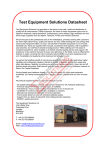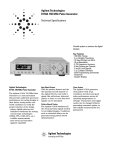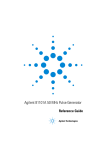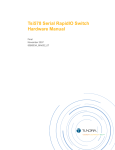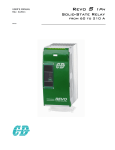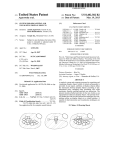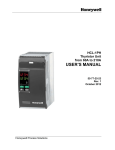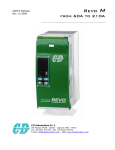Download Agilent Technologies 81100 Family Pulse/Pattern
Transcript
Agilent Technologies 81100 Family Pulse/Pattern Generator Technical Specifications Flexible pulses or patterns for digital designs Introduction to the 81100 Family Signals for testing digital designs and components All members have the same programming/user interfaces, which are compatible with the well-established Agilent 8110A. Migration is therefore easy and cost-effective. The Agilent 81101A, 81104A, 81110A and 81130A generate all the standard pulses and digital patterns needed to test current logic technologies (CMOS, TTL, LVDS, ECL, etc.). With the optional second channel on all of the models from 80 MHz, multi-level and multi-timing signals can be obtained using the internal channel addition feature. · Variable pulse parameters in pattern mode as well as in pulse mode (not on the 81130A) · Synchronously triggerable · Simulation of reflections/ distortions (81104A, 81110A) · Three/four-level codes (81104A, 81110A) Key Features · Common operation with the easy to-use 8110A-type graphical user interface · Common programming. All 81100 models and the 8110A use the same GP-IB/SCPI commands · 100% form/fit compatibility · User-retrofittable channels for most models · Upward compatibility · Individual solutions for frequencies up to 50, 80, 165, 330, 400 and 660 MHz · Pattern mode on all models from 80 MHz. Include pseudo-random binary sequence · The outputs of dual-channel instruments can be added (analog or EXOR, depending on model). Glitch-free timing changes Easy-to-use Now you can sweep your timing values without the danger of spurious pulses or dropouts that could cause measurement errors. (Applies to continuous mode, values < 100 ms, consecutive values between 0.5 and twice the previous value on the 81101A, 81104A, 81110A) Features such as the clear graphical display, autoset, help, store/recall, preset TTL/ECL levels, selectable units (such as current/voltage, width/duty-cycle), and load compensation ensure a high level of convenience. Emulate the device's environment... Today's devices can require very complex stimuli. To meet this, the Agilent 81130A can sequence and loop its memory for very deep patterns. RZ (return-to-zero), NRZ (non-return-to- zero) and R1 (returnto-one) formats are available. Digital channel addition allows the generation of signals with two different pulse widths and delays or of data rates up to 1.32 Gbit/s in one single channel. Smooth integration into automated test systems Reliable measurements All models provide clean, accurate pulses with excellent repeatability, thus contributing to measurement integrity. The Agilent 81110A features selfcalibration for more accuracy. It also offers a choice of output modules: the Agilent 81111A 165 MHz, 10 V module with variable transitions and the Agilent 81112A 330 MHz, 3.8 V module which has differential outputs and two selectable transition times. The Agilent 81100A family can be integrated easily into all phases of test system development. Test programs are 100% upwardly compatible from the Agilent 81101A to the 81104A and from the 81104A to the 81110A, ensuring that growth with future needs is as easy as just exchanging the instruments physically. This results in low integration costs, in addition to low costs of ownership through proven hardware reliability. Frequency range The Agilent 81130A is designed and recommended for an operation in the frequency range of 170 kHz to 400/660 MHz. However it can be operated in the extended range down to 1 kHz. The Agilent 81130A offers a choice of output modules: the Agilent 81131A 400 MHz, 3.8 V module and the Agilent 81132A 660 MHz, 2.5 V module which has complementary outputs. Agilent 81100-Family of Pulse- / Pattern Generators Mainframes 81101A 81104A n.a. 81105A Channel Model 1 1 or 2 Nr. of single single channels Frequency range Period range Variable delay range Period RMSjitter Width range Amplitude range Transition time range (10/90) Dropoutand glitchfree timing change Source Impedance 81110A 3 81111A 81112A 1 or 2 single ended 1mHz – 165MHz 81130A 81131A 81132A 1 or 2 differential ended ended 1mHz – 50MHz 1mHz – 80MHz 20 ns to 999.5 s 0.00 ns – 999.5 s 12.5 ns to 999.5 s 0.00 ns to 999.5 s 6.06 ns to 3.03 ns to 999.5 s 999.5 s 0.00 ns to 999.5 s 2.5 ns to 1 1.5 ns to ms 1 ms 0.00 ns to 3.00 µ s 0.01 % + 15 ps 2 0.01 % + 15 ps 2 0.01 % + 15 ps 2 0.001 % + 15 ps 10 ns to 999.5 s 6.25 ns to 999.5 s 3.03 ns to 999.5 s 1.515 ns to 999.5 s 100 mV to 20.0 V1 100 mV to 20.0 V1 100 mV to 20.0 V1 100 mV to 3.8 V 5.00 ns to 200 ms 3.00 ns to 200 ms 2.00 ns to 200 ms 800 ps or 1.6 ns selectable yes yes 50Ω or 1kΩ 50Ω or 1kΩ 1mHz – 330MHz yes 50Ω or 1kΩ differential 1kHz – 400MHz 1kHz – 660MHz 1.25 ns to (period 1.25 ns) 100 mV to 3.8 V 750 ps to (period 750 ps) 100 mV to 2.5 V 800 ps or 1.6 500 ps typ. ns selectable fixed no 50Ω 50Ω 1.) depends on selected source impedance (all other values apply for 50 Ω source impedance into 50 Ω load) 2.) 0.001% + 15 ps with internal PLL as clock source 3.) Also available as VXI Pulse-/ Pattern Generators E8311A and E8312A 2 Specifications Specifications describe the instrument's warranted performance. Non-warranted values are described as typical. All specifications apply after a 30 minute warm-up phase with 50 W source/load resistance. All specifications are valid from 0°C to 55°C ambient temperature. 81101A Specifications Timing Characteristics Measured at 50% amplitude at fastest transitions in continuous mode and 50 W source impedance. Mainframe Agilent 81101A Frequency range 1 mHz to 50 MHz Timing resolution RMS jitter (period, width, delay) With PLL With VCO [1] Period range Accuracy with PLL 3.5 digits , 5 ps best case Width range Accuracy Additional variable delay range Accuracy [3] Double pulse delay range Accuracy Transition time range (10/90) Accuracy Linearity 0.001% + 15 ps 0.01% + 15 ps 20 ns to 999.5 s ± 0.01% (± 5%) [1] 10.0 ns to (period - 10.0 ns) ± 5% ± 250 ps [2] 0 ns to (period - 20 ns) ± 5% ± 1 ns (width + 10.0 ns) to (period - width - 10.0 ns) ± 5% ± 500 ps 5 ns to 200 ms variable ± 10 % ± 200 ps 3% typ. for transitions > 100 ns Note: [1] If the startable oscillator (VCO) is used (PLL not active). [2] Changing of amplitude may add 0.5 ns. [3] Width accuracy specification is valid up to 5.5 Vpp amplitude. Above this amplitude, the width will typically increase up to 300ps. Burst Count: 2 to 65536 (single or double pulses). Delay: Delay, phase or % of period. Double pulse delay: Double pulse and delay are mutually exclusive. Duty cycle: Set between 0.1% and 95% (subject to width limits. 99.9% with overprogramming). Transition times: These can be entered as leading/ trailing edge or % of width. Leading and trailing edges are independent within one of the following overlapping segments (1:20 ratio): 5 ns - 20 ns, 10 ns - 200 ns, 100 ns - 2 µs, 1µs - 20 µs, 10 µs - 200 µs, 100 µs - 2 ms, 1 ms - 20 ms, 10 ms - 200 ms. Repeatability: Is typically four times better than accuracy Output timing fidelity: Period, delay and width are continuously variable without any output glitches or dropouts. 3 Level/Pulse Performance Characteristics Level specifications are valid after a 30 ns typical settling time. Agilent 81101A Amplitude Level window Accuracy Resolution 50W into 50W 1 kW into 50 W 50 W into 50 W 1 kW into 50 W 50 W into 50 W 1 kW into 50 W 50 W into 50 W 1 kW into 50 W Output connectors Source Impedance Accuracy Max. external voltage Short circuit current Base line noise Overshoot/preshoot/ringing 100 mVpp to 10.0 Vpp 200 mVpp to 20.0 Vpp -10.0 V to +10.0 V -20.0 V to +20.0 V ± (3% + 75 mV) ± (3% + 150 mV) [1] 10 mV 20 mV BNC single-ended Selectable 50 W or 1 kW Typ. ± 1% ± 24 V ±400 mA max. 10 mV RMS typ. Level parameters: Can be entered as voltage or current, as high and low level, or as offset and amplitude. Load compensation: The actual load value can be entered (for loads ³50 W) to display actual output values. On/off: Relays connect/disconnect output (HiZ). Normal/complement: Selectable. Limit: Programmable high and low levels can be limited to protect the device-under-test. ± 5% of amplitude ± 20 mV Note: [1] In ±19 V level window. Trigger Modes Continuous: Continuous pulses, double pulses or bursts (single or double pulses). External triggered: Each active input transition (rising, falling or both) generates a single or double pulse or burst. External gated: The active input level (high or low) enables pulses, double pulses or bursts. The last single / double pulse or burst is always completed. External width: The pulse shape can be recovered, whilst period and width of an external input signal are maintained. Levels and transitions can be set. Manual: Simulates an external input signal. Internal triggered: Internal PLL replaces an external trigger source. Inputs and Outputs Clock input/PLL reference and external input: One input (BNC connector at rear panel) is used for clock input or alternatively for the PLL. PLL Reference: The internal PLL is locked to an external 5 MHz or 10 MHz reference frequency. Clock input: The output period is determined by the signal at CLK input. Ext. input: Used for trigger, gate or external width. Input impedance: 50 W/10 kW selectable. Typical delay times Agilent 81101A Instrument mode External width From EXT. INPUT All other modes EXT. INPUT/CLK INPUT STROBE/TRIGGER OUT 4 To STROBE/TRIGGER OUT OUTPUT 1/OUTPUT 2 STROBE/TRIGGER OUT OUTPUT 1/OUTPUT 2 OUTPUT 1/OUTPUT 2 Typ. value 8.5 ns 22.5 ns 12.0 ns 29 ns 17 ns Threshold: -10 V to +10 V. Max. input voltage: ±15 Vpp. Sensitivity: 300 mVpp typical. Input transitions: <100 ns. Frequency: Dc to 50 MHz . Minimum pulsewidth: 10 ns Strobe output and trigger output Trigger format: One pulse per period with 50% duty cycle typical. External mode: 9 ns typ. Level: TTL or ECL selectable. Output impedance: 50 W typical. Max. external voltage: -2 V/+7 V. Transition times: 1.0 ns typical for TTL, 600 ps typical for ECL. 81104A and 81110A Specifications Timing Characteristics Measured at 50% amplitude at fastest transitions in continuous mode and 50 W source impedance. Mainframe Output module Agilent 81104A Agilent 81105A Frequency range from 1 KW W [1] 1 mHz to 80 MHz Up to 50 MHz typ. Timing resolution 3.5 digits, 5 ps best case RMS jitter (period, width, delay) With PLL With VCO [2] Period range 0.001% + 15 ps 0.01% +15 ps 12.5 ns to 999.5 s Accuracy with PLL Width range Accuracy Add. variable delay range [5] Accuracy [6] Double pulse delay range Min. period ± 0.01% (± 5%) [2] Minimum (with overprogramming) Agilent 81110A Agilent 81112A 1 mHz to 165 MHz Up to 60 MHz typ. 1 mHz to 330 MHz N/A 6.06 ns to 999.5 s 3.03 ns to 999.5 s ± 0.01% (± 0.5% typ. after self-cal., ± 3% without self-cal.) [2] 6.25 ns to (period - 6.25 ns) 3.03 ns to (period - 3.03 ns) ± 5% ± 250 ps ± 0.5% ± 250 ps typ. [3] ± 3% ± 250 ps [4] 0 ns to (period - 12.5 ns) 0 ns to (period - 3.03 ns) ± 5% ± 0.5 ns ± 0.5% ± 0.5 ns typ. [3] ± 3% ± 0.5 ns [4] 12.5 ns to (period - width - 6.25 ns) 6.06 ns to (period - width - 3.03 ns) 3.03 ns to (period - width - 1.5 ns) 25 ns (40 MHz) typ. 12.2 ns (82 MHz) typ. 6.06 ns (165 MHz) typ. Accuracy ± 5% ± 250 ps Transition time range (10/90) Agilent 81110A Agilent 81111A 3 ns to 200 ms variable £ 3 ns 1.515 ns to (period- 1.515 ns) ± 0.5% ± 150 ps typ. [3] ± 3% ± 150 ps [4] 2 ns to 200 ms variable 0.8 ns or 1.6 ns selectable £ 2 ns/1.4 ns typ. for ECL levels (20/80) 5 ns typ. for 1 KW W source imped . £ 600 ps for Vpp £ 1 V 450 ps typ. For ECL levels (20/80) £ 900 ps for Vpp > 1 V Accuracy ± 10 % ± 200 ps Linearity 3% typ. for transitions > 100 ns N/A Notes: [1] Source impedance is selectable from 50 W or 1 KW for the Agilent 81105A and Agilent 81111A. [2] If the startable oscillator (VCO) is used (PLL not active). [3] After self-calibration. [4] Without self-calibration. [5] 0 ns to (period - 17.6 ns) in ext. width mode. [6] Changing of amplitude may add 0.5 ns. Burst Count: 2 to 65536 (single or double pulses). Delay: delay, phase or % of period. Double pulse and delay: mutually exclusive. Duty cycle: set between 0.1% and 95% (subject to width limits. 99.9% with overprogramming). Repeatability: is typ. four times better than accuracy. Transition times: leading/ trailing edge or % of width. Leading and trailing edges are independent Agilent 81111A/Agilent 81105A) within one of the following overlapping segments (1:20 ratio): 2 ns (3 ns) - 20 ns, 10 ns - 200 ns, 100 ns - 2 ms, 1µs - 20 µs, 10 µs - 200 µs, 100 µs - 2 ms, 1 ms - 20 ms, 10 ms - 200 ms. Output timing fidelity: period, delay and width are continuously variable without any output glitches or dropouts. Overprogramming: all parameters of the Agilent 81110A, except transitions, can be set to whatever the 330 MHz timing system will allow. This applies also when the Agilent 81111A (165 MHz) output module is used. 5 Level/Pulse Performance Characteristics Level specifications are valid after a 5 ns (Agilent 81112A) or 30 ns (Agilent 81111A/Agilent 81105A) typical settling time. Mainframe Output module Agilent 81104A Agilent 81105A Agilent 81110A Agilent 81111A Agilent 81110A Agilent 81112A Amplitude 50 W into 50 W 1 KW into 50 W 100 mVpp to 10.0 Vpp 200 mVpp to 20.0 Vpp 100 mVpp to 3.8 Vpp N/A Level window 50 W into 50 W 1 KW into 50 W -10.0 V to +10.0 V -20.0 V to +20.0 V - 2.0 V to +3.8 V N/A Accuracy 50 W into 50 W 1 KWinto 50 W ± (3% + 75 mV) ± (5% + 150 mV) [1] Resolution 50 W into 50 W 1 KW into 50 W 10 mV 20 mV 10 mV N/A Output connectors BNC single-ended BNC differential Source Impedance W Selectable 50 W or 1 KW 50 W only Accuracy ± (1% +50 mV) ± (1% +100 mV) [1] ± (2% +50 mV) N/A Typ. ± 1 % ± 24 V ±400 mA max. (doubles for channel addition) Max. external voltage Short circuit current Dynamic Crosstallk < 0.1% typ.. Baseline noise 10 mV RMS typ. Overshoot/preshoot/ringing -2.2V to +5.5V -84 mA to +152 mA 4 mV RMS typ. ± 5% of amplitude ± 20 mV ± 5% of amplitude ± 50 mV Note: [1] In ±19 V level window. Level parameters: voltage or current, high or low level, offset or amplitude. On/off: relays connect/ disconnect output (HiZ) Load compensation: the actual load value can be entered (for loads ¹ 50 W) to display actual output values. (Applies to the Agilent 81105A and Agilent 81111A only). Normal/complement: selectable. Limit: programmable high and low levels can be limited to protect the device-under-test. Channel Addition (with Agilent 81105A or Agilent 81111A output channels) If the instrument is equipped with 2 output modules, channel 2 can be added to channel 1 internally. In this case the second output is disabled. The additional fixed delay on the second channel is typ. 2.5 ns. The following parameters differ from the above specifications if two output modules (Agilent 81105A/Agilent 81111A) are added. Mainframe Amplitude Agilent 81104A with two Agilent 81105A output modules 50 W into 50 W W into 50 W 1 KW Agilent 81110A with two Agilent 81111A output modules 100 mVpp to 20.0 Vpp 200 mVpp to 20.0 Vpp W Selectable from 50 W or 1 KW Source Impedance Level window 50 W into 50 W 1 KW into 50 W -20.0 V to +20.0 V -20.0 V to +20.0 V Max. frequency 50 W channel 1 KW channel 60 MHz typ. 15 MHz typ. Min. transitions 50 W channel 1 KW channel 2 ns typ. (channel one) 5 ns typ. (channel two) 20 ns typ. both channels 6 Pattern Mode Pattern length: 16 kbit/channel and strobe output. Output format: RZ (return to zero), NRZ (non-return to zero), DNRZ (delayed non-return to zero). Random pattern: PRBS 2^(n-1) n = 7,8,...,14. Trigger Modes Continuous: continuous pulses, double pulses, bursts (single or double pulses) or patterns. External triggered: each active input transition (rising, falling or both) generates a single or double pulse, burst or pattern. External gated: the active input level (high or low) enables pulses, double pulses, bursts or patterns. The last single/double pulse, burst or pattern is always completed. External width: the pulse shape can be recovered. Period and width of an external input signal is maintained. Delay, levels and transitions can be set. Manual: simulates an external input signal. Internal triggered: internal PLL replaces an external trigger source. Pulses, double pulses, bursts or patterns can be set. Inputs and Outputs Clock input/PLL reference and external input PLL reference: (BNC connector at rear panel). The internal PLL is locked to an external 5 MHz or 10 MHz reference frequency. Clock input: (BNC connector at rear panel). The output period is determined by the signal at CLK input. Ext. input: used for trigger, gate or external width. Input impedance: 50 W/10 kW selectable. Threshold: - 10 V to + 10 V. Max. input voltage: ± 15 Vpp. Sensitivity: £ 300 mVpp typical. Transitions: < 100 ns. Frequency: dc to max. frequency of output module. Min. pulsewidth: 1.5 ns (as width of output module in external width mode). Strobe output and trigger output Strobe output: user-defined, 16 kbit pattern (NRZ) when in pattern mode. Trigger format: one pulse per period with 50% duty cycle typical. External mode: 1.5 ns typ. for Agilent 81110A. 5.9 ns typ. for Agilent 81104A. Level: TTL or ECL selectable. Output impedance: 50 W typical. Max. external voltage: - 2 V/+7 V. Transition times: 1.0 ns typical for TTL, 600 ps typical for ECL. Typical delay (Agilent 81110A with Agilent 81111A output module) [1] Instrument mode From To Typ. value External width EXT. INPUT STROBE/TRIGGER OUT OUTPUT 1/OUTPUT 2 8.5 ns 19.5 ns EXT. INPUT/CLK INPUT STROBE/TRIGGER OUT OUTPUT 1/OUTPUT 2 12.0 ns 26.0 ns STROBE/TRIGGER OUT OUTPUT 1/OUTPUT 2 14.0 ns All other modes Note: [1] Subtract 4 ns from the typ. delay value when referring to OUTPUT1/2 for the Agilent 81112A output module and add1 ns when referring to OUTPUT1/2 for the Agilent 81104A with the Agilent 81105A output module. 7 81130A Specifications Timing Characteristics Measured at 50% amplitude at fastest transitions in continuous mode and 50 W source impedance. The Agilent 81130A is designed and recommended for an operation in the frequency range of 170 kHz to 400/660 MHz. However it can be operated in the extended range down to 1 kHz. Changes in specifications below 170 kHz are marked. Mainframe Output module Agilent 81130A Agilent 81131A Frequency range 170 kHz (1 kHz) to 400 MHz Frequency resolution Agilent 81130A Agilent 81132A 170 kHz (1 kHz) to 660 MHz 4 digits, (2 ps best Period range Accuracy RMS jitter (int ref, int clk) Width range 2.5 ns to 5.9 ms (f < 170 kHz: 2.5 ns to 1.0 ±100 ppm 0.001% + 5 ps 1.25 ns to (period - Width resolution 4 digits (2 ps best (f < 170 kHz: 0.05% of Width acccuracy ± (100 ppm + (f < 170 kHz: 0.06% of Width Jitter 1.50 ns to 5.9 ms (f < 170 kHz: 1.5 ns to 1.0 750 ps to (period - 750 ± (100 ppm + 200 (f < 170 kHz: 0.06% of 0.001% + 15 ps 0 to 3.00 ms independent of (f< 333.4 kHz: 0ns... Add. variable delay range 4 digits (2 ps best Delay resolution (f < 170 kHz: 0.05% of ± (0.01 % + 100 ps) relative to the zero- Delay accuracy (f < 170 kHz: ± (0.035% of Delay Jitter Fixed delay (clk in to out) (ext.in to out) 0.001% + 15 ps 53 ns 54 + 0 to 1 period [1] Transition time range: (10/90) 800 ps or 1600 ps Minimum transition (10/90) £ 600 ps for Vpp £ 1 V £ 900 ps for Vpp £ 1 V at ECL levels (20/80) 450 ps typ. Deskew fixed 500 ps typ. <350 ps (200 ps ± 25 ns Note: [1] the uncertainty of 1 period can be eliminated if an external clock and the following setup and hold times are upheld: setup time: 0.3 ns to 4.3 ns; hold time: -2.8 ns to 4.0 ns. Burst Count: 2 to 65504. Delay: delay, phase or % of period. Duty cycle: set between 0.1% and 99,9% (subject to width limits). Repeatability: is typ. four times better than accuracy. 8 Level/Pulse Performance Characteristics Level specifications are valid after a 30 ns typical settling time (50 W into 50 W terminated to ground). Mainframe Output module 81130A 81131A (400 MHz) 81130A 81132 A (660 MHz) 0.10 Vpp to 3.80 Vpp 0.10 Vpp to 2.50 Vpp -2.00 V to +3.80 V -2 .00 V to +3.00 V Accuracy ± (2% +50 mV) ± (5% +50 mV) Resolution 3 digits (10 mV best case) Amplitude Level Window Output Impedance 50 W ±1%typ. 50 W ±5%typ. Max. external voltage - 2.2 to +5.5V -2.0 to +4.0 V Short circuit current -80 mA to +152 mA. -80 mA to +120 mA 4 mV RMS typ. 8 mV RMS typ. ±(5% + 50 mV) of amplitude typ. ±(5% + 100 mV) of amplitude typ. Baseline noise Overshoot/preshoot/ringing On/off: Relays connect/disconnect output (HiZ). Level parameters: Voltage or current, high and low level, or offset and amplitude. Sequencing: A sequence is a succession of segments. One outer loop running once or continuous, and one nested loop can be applied. The nested loop can be set from 1 to 2^20 repetitions. Segment: The memory can be divided into maximal 4 segments. Segment length resolution: This is the resolution for which the segment can be set dependent on the maximum data rate. (see table 1) Pattern and Sequencing Pattern length: 65504 bit/channel. If PRBS is used: (65503-PRBLength) Pattern formats: NRZ (non-return-tozero), DNRZ (delayed non-return-tozero), RZ (return-to-zero) and R1 (return-to-one) can be selected (see figure 1) Output pattern formats 1 0 1 1 Non-return-to-zero NRZ Width is a multiple of clock periods. Delayed Non-Return-to Zero DNRZ The signal can be delayed as required. Return-to-Zero RZ Width and delay can be set as required. Return-To-One R1 Width and delay can be set as required. 1 bit period Figure 1: Pattern Formats Limit: Programmable high and low levels can be limited to protect the device-under-test. Segment types: Pattern, PRBS, high and low segments ( "0" or "1" levels segments selectable). Note: If one channel is set to PRBS the other channel can only be high or low segments, or PRBS type. Random Pattern: PRBS 2^n-1, n = 7,8,...,15 (CCITT 0.151) Required Segment length resolution [1] 1 bit 2 bits 4 bits 8 bits 16 bits Maximum data rate, Mbit/s 41.67 83.88 166.67 333.33 660 Table 1 . Segment length resolution trade-offs [1] The minimum length in the first segment of a nested loop is two times that of the segment length resolution. 9 Digital Channel Addition Channel 1 can be logically combined with channel 2 (XOR) as shown in Figure 2 . The source impedance remains 50 W. Output 1 is still available in this case. Figure 2: Channel addition Trigger Modes Continuous: Continuous pulses, bursts or patterns. External started: Each active input transition (rising, falling edge) generates pulses, bursts or patterns. External gated: The active input level (high or low) enables pulses, bursts or patterns. On an external gate signal the output is immediately stopped, that means the last cycle will not be completed. Manual: Simulates an external input signal with push of a front panel button. Inputs and Outputs Clock input/PLL reference and external input Connectors: SMA (f) 3.5 mm Input impedance: 50 W Termination voltage: -2.10 V to 3.30 V Input sensitivity: < 400 mV typ. Max. Input Voltage: -3 V to + 6 V Input transitions: < 20 ns Only valid for clock input/PLL reference One input is used for clock input or for the PLL reference alternatively. Reference: The internal PLL is locked to the 1,2,5 or 10 MHz . External clock: The output period is determined by the signal at clock input. Clock Input frequency: 170 kHz to 660 MHz (at 50% ±10% duty cycle) Delay from input trigger output: 21ns. Delay from input to output: 53ns Threshold: ac coupled Only valid for external input External input: Used for external started or gated Input frequency: DC to 330MHz Delay from external input to trigger output: 22ns + 0 to 1 period Delay from external input to output: 54 ns + 0 to 1 period Threshold: -1.4 V to +3.7 V Trigger output Trigger format: One pulse per period with 50% duty cycle typical. In pattern mode the trigger pulse can be set to mark the start of any segment. Output impedance: 50 W typical. Level: TTL/ETTL (for frequency < 180 MHz), 1 V to GND, ECL 50 W to GND/-2 V, PECL 50 W to + 3 V. Max. external voltage: - 2 V/+3 V. Transition times: 1.0 ns typical for TTL, 600 ps typical for ECL. Delay from external input to trigger output: 32 ns typical Programming times: (measured at display off.) ASCII Command Typical execution time Width, dalay,transition times 40 ms to 70 ms 100 ms to 260 ms Period within one range [1] Period between different ranges [1]: In pulse/burst mode in pattern mode Levels Trigger modes Input parameters Save setting Recall setting: a) in pulse/burst mode b) in pattern mode with data and PRBS (depends on setting) 65504 bit pattern transfer Pattern and sequencing (depends on setting) [1] Range depends on segment length resolution, see table 1 10 140 ms to 300 ms 100 ms to 5.05 s 43 ms < 75 ms 28 ms 200 ms 515 ms to 800 ms 1.15 s to 5.5 s 1.25 s 190 ms to 5.1 s Common Specifications General User Interface Overprogramming: all parameters can be overprogrammed (exceeding specifications) to fully exploit the hardware limits. Setting check: warning messages indicate potentially conflicting parameters due to inaccuracy. Error messages indicate conflicting parameters. Help key: displays a context-sensitive message. Autoset key: resolves all timing conflicts. Non-volatile memory: current setting is saved on power-down. Up to nine user settings and one fixed default setting can be stored in the instrument. Memory card: 99 settings can be stored on a 1 MB PCMCIA card (MS-DOSâ). Remote Control Operates according to IEEE standard 488.2, 1987 and SCPI 1992.0. Function Code: SH1, AH1, T6, L4, SR1, RL1, PP0, DC1, DT1, C0. Operating temperature: 0°C to +55°C. Storage temperature: -40°C to +70°C. Humidity: 95% r.h. up to 40°C ambient temperature. EMC: conforms to EN50082-1, EN 55011, Class A. Noise emission: 5.7 bel typical. Battery: Lithium CR2477-N. Safety: IEC1010, CSA1010. Power requirements: 100-240 Vac, ± 10%, 50-60 Hz; 100-120 Vac, ± 10%, 400 Hz. Power consumption: 300 VA max. Max. dimensions (H * W * D): 89 mm * 426 mm * 521 mm. Weight: 9.2 kg net, 13.8 kg shipping. Recalibration period: one year recommended. Warranty: three years standard. ASCII command Typ. exec. time One parameter or mode 30 ms typ. Recall setting 250 ms typ. 16 k pattern transfer 600 ms typ. Programming times: all checks and display off. 11 Ordering Information - 81100 Family The minimum configuration for a working instrument consists of a mainframe and one output module. The second output module can be added later. Output modules can be exchanged and retrofitted by the user. The English Quick Start Guide (811xx-91010) and Reference Guide (811xx-91011) is supplied with each mainframe for all configurations. A memory card is not included. Each Agilent 81101A includes just one output channel (in comparison to the other models of the Agilent 81100 family). The output module of the 81101A does not need to be ordered separately. Agilent 81101A 50 MHz one channel Pulse Generator, 10V Quick Start Guide language options Opt ABF French Guide (81101-91210) Opt ABJ Japanese Guide (8110191510) Opt AB0 Taiwan Chinese Guide (81101-91610) Opt AB1 Korean Guide (81101-91710) Opt AB2 Chinese Guide (81101-91810) Additional documentation options Opt 0BW Service Manual (8110191021) 81101-91031 Service Documentation (Component Level) Agilent 81104A 80 MHz Pulse/Pattern Generator Mainframe Agilent 81130A 400/660 MHz Pulse/Data Generator Mainframe Output module: Agilent 81105A 80 MHz, 10 V Output modules: Agilent 81131A 400 MHz, 3.8 V Agilent 81132A 660 MHz, 2.4 V Agilent 81110A 330/165 MHz Pulse/Pattern Generator Mainframe Output modules: Agilent 81111A 165 MHz, 10 V Agilent 81112A 330 MHz, 3.8 V Note: Only add together output modules of the same module number. A combination of the Agilent 81111A and Agilent 81112A in one Agilent 81110A is not possible. Quick Start Guide language options Opt ABF French Guide (81110-91210) Opt ABJ Japanese Guide (8111091510) Opt AB0 Taiwan Chinese Guide (81110-91610) Opt AB1 Korean Guide (81110-91710) Opt AB2 Chinese Guide (81110-91810) Additional documentation options Opt 0BW Service Manual (8111091021) 81110-91031 Service Documentation (Component Level) All options are orderable with the mainframes. Accessories Opt UN2 Rear Panel Connectors (instead of front panel) Opt 1CP Rack Mount and Handle Kit (5063-9219) Opt 1CN Handle Kit (5063-9226) Opt 1CM Rack Mount Kit (5063-9212) Opt 1CR Rack Slide Kit (1494-0059) Opt UFH 1 MB SRAM Memory Card (0950-3380) Opt 1BP MIL Std. 45662A Calibration with Test Data Opt UK6 Commercial cal. certificate with Test Data Agilent 15104A Pulse Adder/Splitter 12 Note: Only add together output modules of the same module number. A combination of the Agilent 81131A and Agilent 81132A in one Agilent 81130A is not possible. Quick Start Guide language options Opt ABF French Guide (81130-91210) Opt ABJ Japanese Guide (8113091510) Opt AB0 Taiwan Chinese Guide (81130-91610) Opt AB1 Korean Guide (81130-91710) Opt AB2 Chinese Guide (8113091810) Additional documentation options Opt 0BW Service Manual (8113091021) 81130-91031 Service Documentation (Component Level) Related Agilent Literature Agilent Family of Pulse/Pattern Generators, brochure, p/n 5980-0489E For more information, please visit us www.agilent.com/find/pulse_generator Agilent Technologies' Test and Measurement Support, Services, and Assistance Agilent Technologies aims to maximize the value you receive, while minimizing your risk and problems. We strive to ensure that you get the test and measurement capabilities you paid for and obtain the support you need. Our extensive support resources and services can help you choose the right Agilent products for your applications and apply them successfully. Every instrument and system we sell has a global warranty. Support is available for at least five years beyond the production life of the product. Two concepts underlay Agilent's overall support policy: "Our Promise" and "Your Advantage." Our Promise Our Promise means your Agilent test and measurement equipment will meet its advertised performance and functionality. When you are choosing new equipment, we will help you with product information, including realistic performance specifications and practical recommendations from experienced test engineers. When you use Agilent equipment, we can verify that it works properly, help with product operation, and provide basic measurement assistance for the use of specified capabilities, at no extra cost upon request. Many self-help tools are available. Your Advantage Your Advantage means that Agilent offers a wide range of additional expert test and measurement services, which you can purchase according to your unique technical and business needs. Solve problems efficiently and gain a competitive edge by contracting with us for calibration, extra-cost upgrades, out-of-warranty repairs, and on-site education and training, as well as design, system integration, project management, and other professional services. Experienced Agilent engineers and technicians worldwide can help you maximize your productivity, optimize the return on investment of your Agilent instruments and systems, and obtain dependable measurement accuracy for the life of those products. By internet, phone, or fax, get assistance with all your test & measurement needs Online assistance: www.agilent.com/find/assist Phone or Fax United States: (tel) 1 800 452 4844 Canada: (tel) 1 877 894 4414 (fax) (905) 206 4120 Europe: (tel) (31 20) 547 2000 Japan: (tel) (81) 426 56 7832 (fax) (81) 426 56 7840 Latin America: (tel) (305) 267 4245 (fax) (305) 267 4286 Australia: (tel) 1 800 629 485 (fax) (61 3) 9272 0749 New Zealand: (tel) 0 800 738 378 (fax) 64 4 495 8950 Asia Pacific: (tel) (852) 3197 7777 (fax) (852) 2506 9284 Product specifications and descriptions in this document subject to change without notice. Copyright ©2001 Agilent Technologies Printed in Germany October 1st, 2002 5980-1215E













